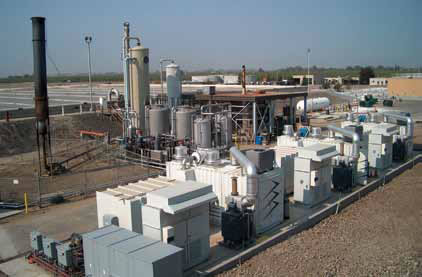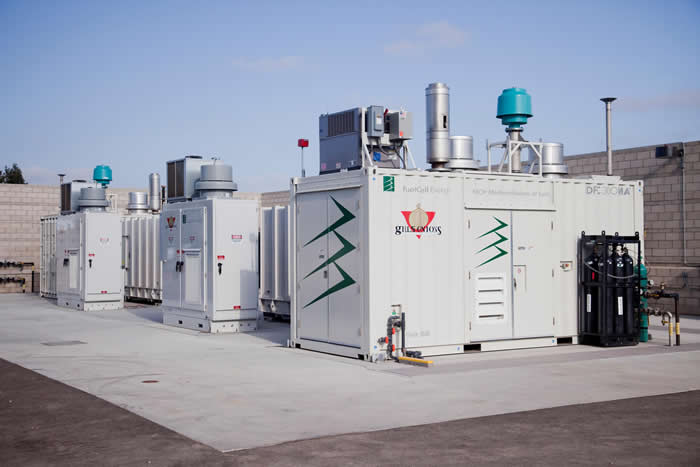These installations help propel not only FuelCell Energy's image and financial stability, but also California's standing as a fuel cell leader in not only the United States, but the world.
FuelCell Energy Fuel Cell Systems in California
Contributed by | Fuel Cells 2000
In recent months, there have been several large-scale sales of FuelCell Energy fuel cell systems to wastewater treatment plants, municipal facilities, and even an egg ranch in California. These units will be powered by biogas, making them eligible for California’s generous Self Generation Incentive Program (SGIP). SGIP provides $4,500 per kW for fuel cell systems running off of renewable fuel, which includes biogas or anaerobic digester gas (ADG).
Since ADG contains hydrogen, it is a perfect fit for fuel cells and by utilizing the waste gas that would normally be released into the atmosphere for power and cogeneration (also known as combined heat and power or CHP) at the facility, the fuel cell systems are achieving efficiencies of 85% and higher. Fuel cells running on ADG are estimated to release only 72 pounds of emissions into the environment, compared to more than 41,000 pounds of pollutants from the average coal- or oil-fired plant. New York, through the New York Power Authority (NYPA) and the New York State Energy Research and Development Authority (NYSERDA) have placed numerous fuel cells (from UTC Power, another fuel cell manufacturer) at wastewater treatment plants in the early 2000s and all three of Japan’s major breweries (Kirin, Asahi and Sapporo) have all used fuel cells running off the ADG generated from brewing affluent.
California is following suit and the SGIP program has helped propel California to one of the world’s leaders in stationary fuel cell installations and is leading to some big installations in the wastewater treatment and food and beverage processing field. Already boasting installations at Sierra Nevada Brewery, Gills Onions (running of ADG created from onion waste), a Napa winery and various wastewater facilities around the state, this recent spurt of installations are helping to greatly reduce waste and emissions while increasing renewable power as well as reliability and efficiency of the facilities.
The recent sales from FuelCell Energy units running off ADG total more than 10 MW of power.
Three fuel cell power plants, ranging from 2.8 MW, to 1.4 MW and a 300 kW unit, will be installed around San Diego, California. The 4.5 MW purchase from BioFuels Fuel Cells, LLC, a California renewable energy company owned by New Energy Capital and BioFuels Energy, LLC, will be installed at three different locations and will utilize purified biogas from the Point Loma Wastewater Treatment Plant in San Diego. This project incorporates a unique solution that purifies the biogas on site, and then injects the biogas into an existing gas pipeline to supply fuel cells at two different locations in the San Diego area. This project will represent the first time that a FuelCell Energy fuel cell will be fueled by renewable biogas generated at a distant location.
The three fuel cell systems will utilize the waste head, bringing the efficiency to 90%, the projects are:
University of California, San Diego - 2.8 MW DFC3000 to supply power to the campus electrical grid. The University will utilize the byproduct heat from the fuel cell energy generation process as a continuous power source for 320 tons of chilling capacity to cool campus buildings, increasing the overall efficiency of the power plant and generating cost savings for the University. When completed in late 2011, the 2.8-megawatt fuel cell will be the largest on any college campus, providing about 8 percent of UC San Diego’s total energy needs. The $19 million project requires no university funding: the project is eligible for $7.65 million from SGIP, and BioFuels Energy will provide the remaining $11.35 million in private investment, loans, and investment tax credits.
South Bay Water Reclamation Plant - This municipal facility is a pump station that does not generate biogas on site. The 1.4 MW DFC1500 fuel cell power plant will provide reliable base-load power around-the-clock, replacing power purchased from the electric grid. Byproduct heat will be used for heating needs at the pump station, increasing the overall efficiency of the power plant.
 Point Loma Wastewater Treatment Plant - 300 kW DFC300 fuel cell will generate the power required for the biogas purification process. Biogas generated from the wastewater treatment process will fuel the DFC300 power plant and provide directed biogas to the existing gas pipeline.
Point Loma Wastewater Treatment Plant - 300 kW DFC300 fuel cell will generate the power required for the biogas purification process. Biogas generated from the wastewater treatment process will fuel the DFC300 power plant and provide directed biogas to the existing gas pipeline. The City of San Diego estimates the project will generate $2.6 million of revenue over ten years from payments made by BioFuels Energy for the biogas. In addition, the City expects to save $780,000 in electricity costs to power the South Bay Water Reclamation Plant under a ten year power purchase agreement with BioFuels Energy.
For its Ontario, California, water recycling plant, Inland Empire Utilities Agency (IEUA) signed a landmark 20-year power purchase agreement (PPA) with UTS Bioenergy to install, operate and maintain a 2.8 MW fuel cell system, fueled primarily with renewable biogas. The fuel cell system will provide power and thermal energy to the water recycling plant and is expected to be operational by late 2012.
UTS Bioenergy also purchased a 1.4 MW DFC1500 for the San Jose/Santa Clara Water Pollution Control Plant in San Jose, California. As with the Ontario plant, UTS entered into a 20-year power purchase agreement for the unit which is expected to be operational in early 2012.
FuelCell Energy also sold another 1.4 MW DFC1500 fuel cell power plant to the Rancho California Water District to power a pumping station located in Temecula, California. The fuel cell is expected to be operational by late 2011.
One the small side, the company sold two 300 kW DFC300 fuel cell power plants to the Eastern Municipal Water District (EMWD) in southern California to be fueled by renewable biogas. The fuel cells will be located at the Perris Valley Regional Water Reclamation Facility in Riverside County, California and are expected to be operational by mid 2011.
Finally, FuelCell Energy, Inc. also sold a 1.4 MW DFC1500 fuel cell power plant to G3 Power Systems, Inc. to be installed at the Olivera Egg Ranch, LLC, a poultry ranch located in French Camp, California that produces approximately 14 million cartons of eggs per year for stores and restaurants in the San Francisco Bay Area. The anaerobic digester that will be installed that will process more than 1 million pounds of poultry waste per week, helping to reduce the ranch’s waste it dumps into a waste lagoon, and the ADG generated will power the fuel cell to provide electricity for the ranch.

These installations help propel not only FuelCell Energy’s image and financial stability, but also California’s standing as a fuel cell leader in not only the United States, but the world. For a complete listing for stationary installations in California, please visit Fuel Cells 2000’s State Fuel Cell and Hydrogen Database - http://www.fuelcells.org/info/statedatabase.html.
The content & opinions in this article are the author’s and do not necessarily represent the views of AltEnergyMag
Comments (0)
This post does not have any comments. Be the first to leave a comment below.
Featured Product

MORNINGSTAR - GenStar MPPT
GenStar MPPT is the industry's first fully integrated solar DC charging system, an all-new design with "lithium DNA" from the leader in charge controllers. Out of the box, GenStar is an overachiever-delivering legendary Morningstar quality, efficiency, power and reliability along with the latest in advanced communications and control technologies. All the most installer-requested features are on-board; additional features can be easily added via Morningstar's ReadyBlock expansion technology, with snap-in blocks that provide battery metering and monitoring, signaling and load control, and lithium battery communications/control
